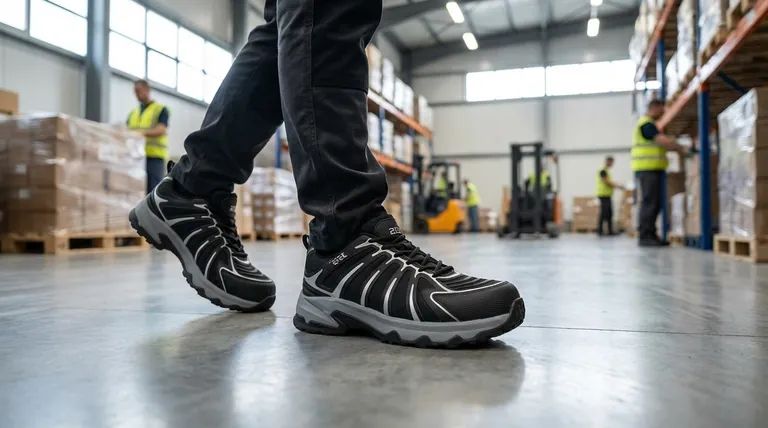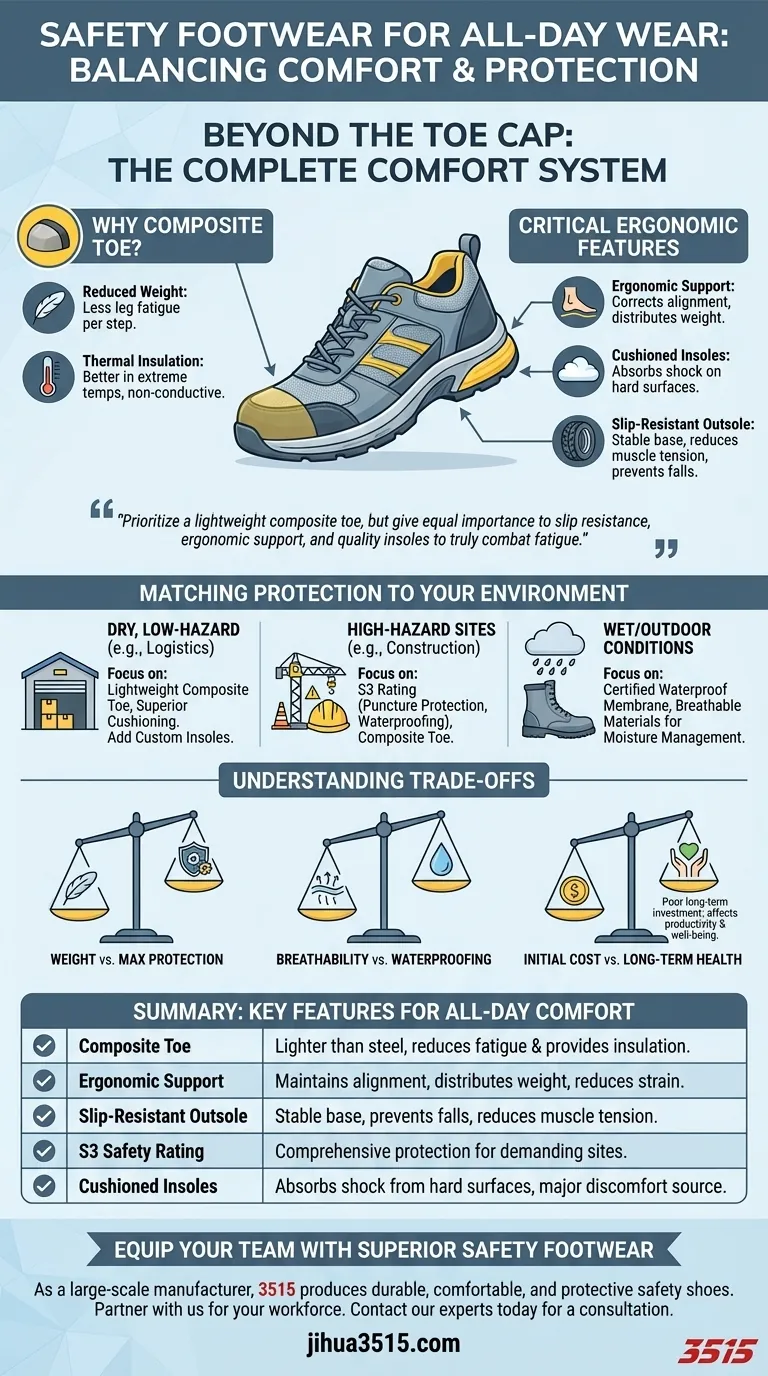Choosing the right safety shoe for all-day wear goes far beyond selecting a protective toe cap. For workers who are on their feet for extended periods, the ideal choice is a composite toe shoe, which is significantly lighter than its steel counterpart. However, true comfort and safety are achieved through a combination of features, including superior cushioning, ergonomic arch support, and a slip-resistant design.
The most effective safety footwear for all-day use is not a single type of shoe, but rather a system of components. Prioritize a lightweight composite toe, but give equal importance to slip resistance, ergonomic support, and quality insoles to truly combat fatigue and ensure safety.

Beyond the Toe Cap: The Core of All-Day Comfort
Many workers focus solely on the protective toe, but the features that prevent fatigue and strain over an eight-hour shift are found throughout the shoe's construction.
Why Composite Toes Outperform Steel for Long Shifts
The primary benefit of a composite toe cap is its reduced weight. While steel toes offer excellent protection, their heft contributes to leg fatigue with every step you take.
Composite materials do not conduct heat or cold like metal, providing better thermal insulation and keeping your feet more comfortable in extreme temperature environments.
The Critical Role of Ergonomic Design
A shoe's internal structure is paramount for preventing foot pain. Ergonomic design and proper arch support help maintain correct foot alignment and distribute your body weight evenly.
Features like cushioned insoles and energy-absorbing heels work together to reduce the shock of walking on hard surfaces like concrete, which is a major source of discomfort.
The Foundation of Support: Quality Outsoles
A high-quality, slip-resistant outsole does more than just prevent falls. It provides a stable base that allows you to move confidently and naturally, which reduces muscle tension in your feet, legs, and back over the course of a long day.
Matching Protection to Your Environment
True safety requires matching your footwear's capabilities to the specific hazards of your workplace. Understanding safety ratings helps you make an informed choice.
Comprehensive Protection for Demanding Sites (S3 Rating)
For environments like construction sites or heavy industry, a higher level of protection is non-negotiable. An S3-rated safety shoe is a common and reliable standard.
These shoes include an impenetrable midsole to protect against punctures from nails or glass, a waterproof upper, a safety toecap, and an anti-slip, energy-absorbing heel.
The Power of Customization with Insoles
Even the best work shoes can be enhanced. If you have specific foot conditions like flat feet or high arches, high-quality aftermarket insoles can provide tailored arch support and extra shock absorption.
This small addition can make a significant difference in comfort and reduce the risk of chronic foot problems.
Understanding the Trade-offs
Choosing the perfect safety shoe involves balancing competing priorities. Being aware of these trade-offs will help you select the best option for your specific needs.
Weight vs. Maximum Protection
More protective features, such as puncture-resistant plates and waterproofing, inevitably add weight. The lightest composite shoe may not be suitable for a high-hazard construction site, so you must balance the need for comfort with the required level of safety.
Breathability vs. Waterproofing
A fully waterproof shoe is essential for wet conditions but is often less breathable than other footwear. In hot, dry environments, this can lead to sweaty, uncomfortable feet. Consider your typical work climate when making a choice.
Initial Cost vs. Long-Term Health
It can be tempting to choose a less expensive safety shoe, but this is often a poor long-term investment. A poorly constructed shoe can contribute to foot, knee, and back pain, ultimately impacting your productivity and well-being.
Making the Right Choice for Your Goal
Filter your options based on your primary daily requirements to find the ideal balance of safety and comfort.
- If your primary focus is comfort in a dry, low-hazard environment (e.g., logistics, light manufacturing): Prioritize a lightweight composite toe shoe with excellent cushioning and consider adding a custom insole for tailored support.
- If your primary focus is safety on a high-hazard site (e.g., construction, heavy industry): Look for an S3-rated shoe with a composite toe to balance comprehensive protection with reduced fatigue.
- If your primary focus is working in wet or outdoor conditions: Ensure your choice has a certified waterproof membrane, but also look for modern breathable materials to help manage moisture from the inside.
Investing in a safety shoe that addresses both protection and ergonomics is the most effective way to ensure your safety and well-being day after day.
Summary Table:
| Feature | Why It Matters for All-Day Wear |
|---|---|
| Composite Toe | Lighter than steel, reduces leg fatigue and provides thermal insulation. |
| Ergonomic Support | Maintains proper foot alignment, distributes weight, and reduces strain. |
| Slip-Resistant Outsole | Provides a stable base, prevents falls, and reduces muscle tension. |
| S3 Safety Rating | Ideal for demanding sites; includes puncture protection and waterproofing. |
| Cushioned Insoles | Absorbs shock from hard surfaces, a major source of foot discomfort. |
Ready to Equip Your Team with Superior Safety Footwear?
As a large-scale manufacturer, 3515 produces a comprehensive range of safety shoes and boots designed for durability, comfort, and protection. We serve distributors, brand owners, and bulk clients with production capabilities encompassing all types of occupational footwear.
Partner with us to provide your workforce with footwear that combines safety with all-day comfort, boosting productivity and well-being.
Contact our experts today for a consultation and discover how we can meet your specific needs.
Visual Guide

Related Products
- Premium KPU Athletic Safety Shoes for Wholesale
- Durable Rubber-Soled Utility Shoes for Wholesale & Custom Brand Manufacturing
- Wholesale Leather Safety Boots with Customizable Protective Toe
- Wholesale Durable Breathable Safety Boots Custom OEM Manufacturer
- Wholesale Breathable Training Shoes Custom Athletic Footwear Manufacturer
People Also Ask
- Why is expert help recommended when selecting safety shoes? Ensure Perfect Fit & Hazard Protection
- What types of workplace hazards require protective footwear? Essential Guide for Workplace Safety
- What are the EN ISO 20345 norms for safety shoes? A Guide to Choosing the Right Protection
- What materials are used in the construction of these boots? A Guide to Velour Leather, Textile & PU Soles
- What should warehouse work shoes include for safety? Essential Features for All-Day Protection



















